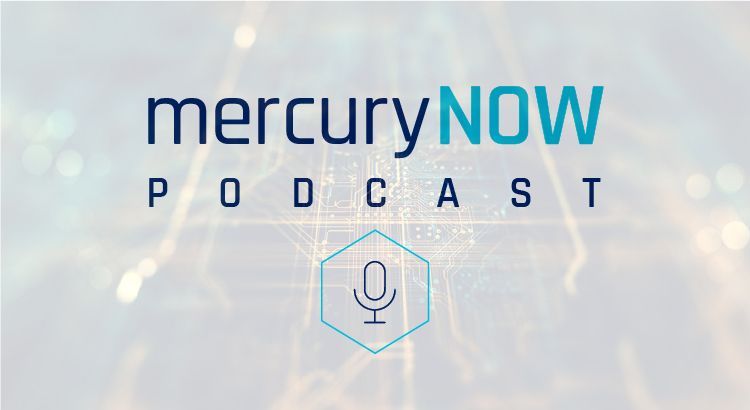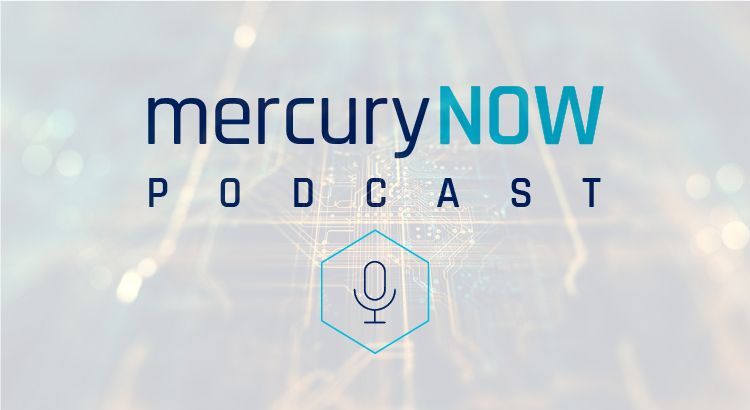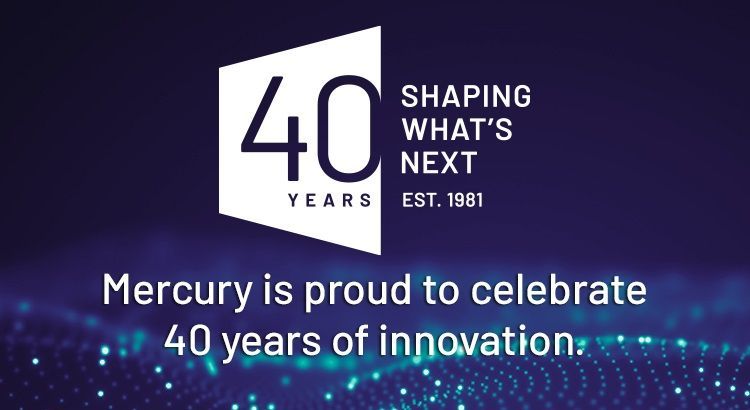
Delivering high-quality and highly reliable memory products through industry partnerships
Mercury Systems
July 13, 2021
Ralph Guevarez:
Hello and welcome to Mercury Now, a podcast series brought to you by Mercury Systems. I am your host, Ralph Guevaras, and today's topic; how Mercury and Micron deliver memory products with semiconductor supply chain integrity. Joining me today is John Wiemeyer, principal product manager for data here at Mercury Systems, and our special guest, John Votino, senior business development manager at Micron. John V, John W, good day, and welcome to the show.
John Wiemeyer:
Thanks, Ralph.
John Votino:
Thanks, Ralph. Happy to be here,
Ralph Guevarez:
John V, you are our guest today. So if you please, could you give our listeners a brief background on your current role at Micron?
John Votino:
Yeah, absolutely. So I'm the senior manager for Micron's embedded business. It's one of four business units within Micron and my business unit supports embedded applications.
Ralph Guevarez:
Great. Thank you. John W, please, a brief background.
John Wiemeyer:
Thanks, Ralph. I'm the principal product manager for memory products in the microelectronics division of Mercury Systems.
Ralph Guevarez:
Now, why does memory and storage solutions matter and how are they used? John V, let's start with you please.
John Votino:
Yeah, sure. Ralph. I'd say that memory and storage solutions matter, especially for mission critical applications like aerospace and defense. To that end, one of the key aspects of meeting the needs of these platforms is collaboration. Collaboration and selecting the right device. To that end, Micron has been supporting the industrial multi-market now for 25 plus years as a trusted advisor, and we've developed a concept that we call industrial quotient, or IQ Matter, which is really to meet the needs of these platforms. Our IQ propositions really offering longevity, ruggedness, reliability, and quality, quite often with product enhancement for application specific requirements. They really reflect the needs of the market and at the same time, we try to focus on simplifying product lifecycle management.
Ralph Guevarez:
Thank you, John. John W, your thoughts please?
John Votino:
Sure. Thanks, Ralph. So much like John was saying, missions and aerospace and defense are critical and must succeed, which is the reason Mercury builds highly reliable memory products. Failure of a mission in aerospace and defense is not an option. This is a reason Mercury builds rugged memory modules using Micron's highly reliable dye in their Manassas, Virginia fab. Mercury customers are concerned really about three aspects of the memory. We call SWAP, which is size, weight, and power. These factors greatly influenced the system's performance in an application and ruggedness ensures a longevity, and longevity in operation as well as availability are key factors for Mercury customers, which is the reason Mercury builds are rugged SWAP-optimized memory modules using Micron dye fabricated in their Manassas, Virginia fab.
Ralph Guevarez:
Thank you both for your insights. My next question, what goes into rugged memory modules and also how are they constructed? John V, let's start with you please.
John Votino:
Yeah, sure, Ralph. Great question, actually. So ruggedness is actually one of the key components to our industrial quotient program as I've been talking about, our IQ Matters program. From a ruggedized product perspective, they really require enhancements that are needed to enable performance and functionality across extreme environments. This is why some of Micron products support those needs. Some of those products support extended temperature ranges, thermal cycling, stock humidity, and other application specific requirements to meet the needs of the application. All of these requirements, by the way, are detailed out in our product datasheets.
Ralph Guevarez:
Thank you, John. John W, same question, please.
John Wiemeyer:
Ruggedness is all about the components we use and the testings that our modules are required to pass. It starts really with a Micron dye, and then from there, we always make sure that the materials used in our modules have a matched CTE to ensure that the module will maintain its integrity during thermal cycles. We have an encapsulant that protects the sensitive dye that's inside the module, and that encapsulant conducts heat from the inside of the module to the outside and protects the electronic, the dye, that's actually inside the module. Finally, to ensure every module is rugged, we go through environmental testing, which includes thermal cycles and temperature, humidity, and biased, and highly accelerated stress test, which confirms that every module designed is a rugged module.
Ralph Guevarez:
Could you tell me more about the quality processes around building memory modules? John V, your thoughts please?
John Votino:
Yeah, sure thing, Ralph. Micron really employs extensive quality testing, really in an effort to minimize and control variants and deliver consistent performance across processes and products. We accomplished this through rigorous screening, product level testing and assembly and process monitoring. All of this combined helps to ensure the quality of Micron products.
Ralph Guevarez:
Thank you, John. John W, your thoughts please.
John Wiemeyer:
So Mercury is an AS 9100 certified supplier and AS 9100 is the international quality management system standard for aviation space and defense industry and created by the international aerospace quality group. The standard provides suppliers with requirements for creating and maintaining comprehensive quality systems for providing safe and reliable products to the aerospace and defense industry, as well as civil and military aviation requirements. So AS 9100 certified means an organization has met the requirements of AS 9100D, and this is the key to quality in our products.
Ralph Guevarez:
What kind of reliability testing do Micron and Mercury Systems do? John W, let's start with you.
John Wiemeyer:
As I mentioned earlier, Mercury fully tests every module designed for environmental ruggedness using temperature cycles, highly accelerated stress test, or HAST, and temperature, humidity, and bias, or as we call it, THB. Humidity and bias work together to create an environment for electro migration. If electro migration isn't prevented, the result is failure of a component and Mercury is environmental testing confirms our memory modules will not fail due to electro migration. We also use a eutectic tin lead solder, which eliminates the possibility of tin whiskers and we 100% percent burn-in every module. So every module Mercury ships is 100% tested and burned in to ensure it meets our D-sheet specifications.
Ralph Guevarez:
Thank you, John. John V, reliable testing for Micron, please.
John Votino:
I'd say that Micron's design and testing processes in general add a high level of endurance and reliability that align with the needs for long lifecycle embedded applications. Aspects such as average failure rate, failure rate time, meantime before failure and other insurance metrics along with spec guard-band methodology really highlights the quality of Micron products. Also, ensuring that these metrics are measured for practical usage model, including temperature and variation and read and write characteristics.
Ralph Guevarez:
Let's talk about longevity. How do you ensure longevity in a program cycle? John V, let's start with you this time.
John Votino:
So there's actually two aspects of that that Micron employs to ensure longevity. One is that Micron has expanded its Manassas, U.S., fabrication site to support the rapidly growing needs for high-quality, high-reliability memory solutions. This site manufactures our long lifecycle products to ensure supply continuity. For applications that require an either longer amount of time from a lifecycle perspective, Micron has a product longevity program which we call PLP. For select DRAM, NAND and NOR products, it really provides a minimum 10-year form fit function compatibility from the date that we actually introduced the products. All of this combined gives us the ability to deliver leading edge, state-of-the-art memory portfolio with associated lifecycle support that enables Micron to support applications from industries with complex longevity requirements. One of the focuses of all of this from a longevity perspective as well as some of the aspects we've discussed earlier is to really focus on lowering the total cost of ownership of the product in addition to providing longevity for the product.
Ralph Guevarez:
Thank you, John. John W, longevity in a program cycle, please.
John Wiemeyer:
Well, as John stated, Mercury and our customers rely on Micron's long life support offered through its fab in Manassas, Virginia, as well as its PLP program. But in the event Micron does EOL a dye, they offer a last-time buy process that Mercury uses to support existing programs while we redesign a module to use the replacement dye that Micron makes available to us. Then the new module will be a fit, form and function replacement to the original module that customers can continue their program using that same module. It's a fit, form and function.
Ralph Guevarez:
Thank you both again for your insights. John W, Micron enables Mercury Systems to use advance packaging technology. Could you explain more about this specifically, please?
John Wiemeyer:
Well, sure. Really what our packaging is about is we're taking Micron's dye and we're stacking it internally. So we're not spreading the dye, a packaged part, across the circuit board, but we're stacking Micron dye. That then enables the SWAP optimization we talked about earlier, size, weight, and power, and really of those, it's the size that is saved. I mean, we do save something because we're not putting all the packaging and the lead frames as well, but it's the size that is greatly reduced by stacking dye. We put an RDL on the dye that brings those center rows out so we can bond to them. That's how we create a highly swap optimized memory solution using Micron dye.
Ralph Guevarez:
Thank you, John. I want to take this opportunity to thank you both for your time. Great discussion. Could you please tell our listeners where they can find more information on the topic? John V, let's start with you.
John Votino:
Yeah, sure can. Actually, very engaging discussion, Ralph. Thank you very much for your time in moderating. I just wanted to close out by saying that Micron has been the trusted advisor to our industrial multi-market customer for more than 25 years now, and we understand the unique needs of this market, and we bring a mindset to deliver sustainable value because we firmly believe in our concept of industrial quotient, or what we call IQ Matters. We firmly believe that IQ matters to our customers to find out more information about our IQ Matters program, you can go to micron.com and again, thanks for your time.
Ralph Guevarez:
Thank you, John. John W, please.
John Wiemeyer:
Yeah. Thanks, Ralph.,And thanks for moderating. So Mercury Systems specializes in three-dimensional packaging of commercial technology memory to produce high grade, high reliability, high density, secure memory solutions, and you can find out more by visiting mrcy.com/memory.
Ralph Guevarez:
Gentlemen, Godspeed moving forward, and thank you again for your time.
John Wiemeyer:
Thanks, Ralph.
John Votino:
Thanks, Ralph.
Ralph Guevarez:
This has been another edition of Mercury Now, a podcast series brought to you by Mercury Systems. I am your host, Ralph Guevaras, signing off.





 Innovating past the need for compromise for your embedded computing
Innovating past the need for compromise for your embedded computing Shaping what’s next: 40 years of innovation
Shaping what’s next: 40 years of innovation